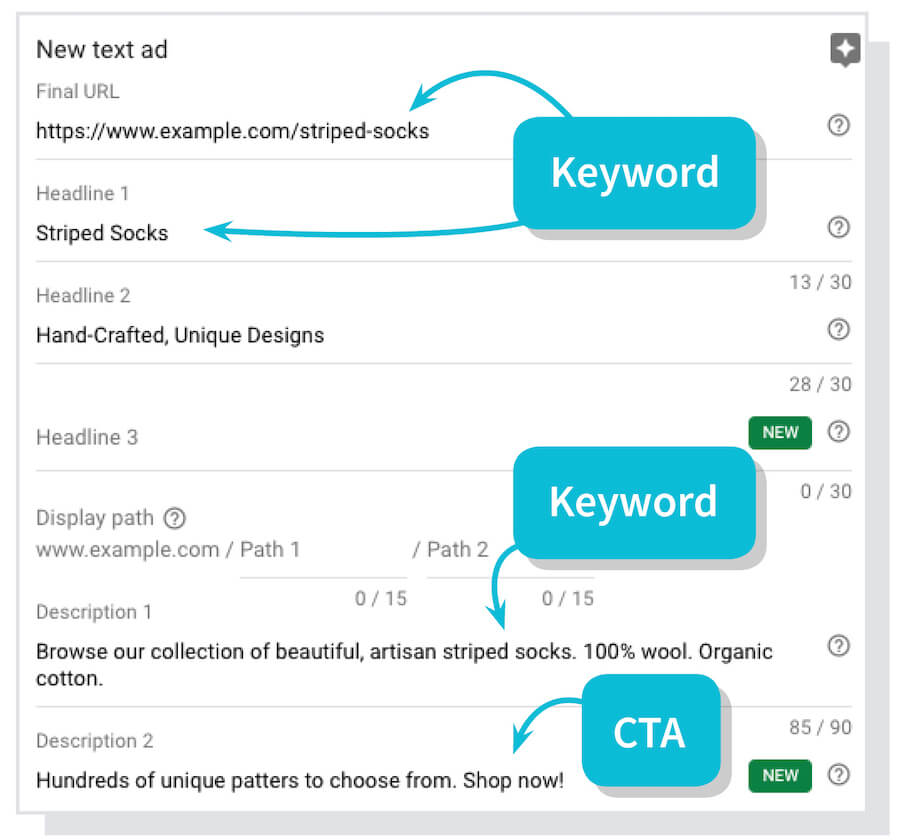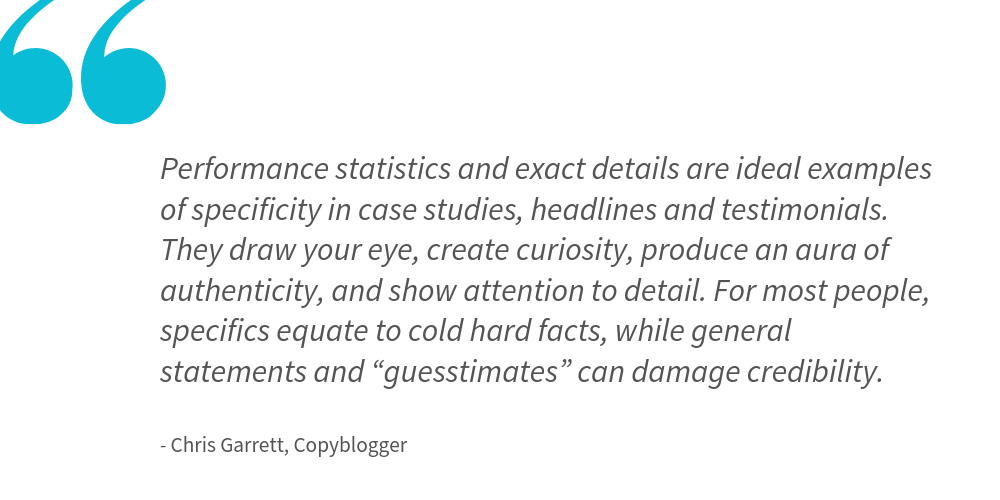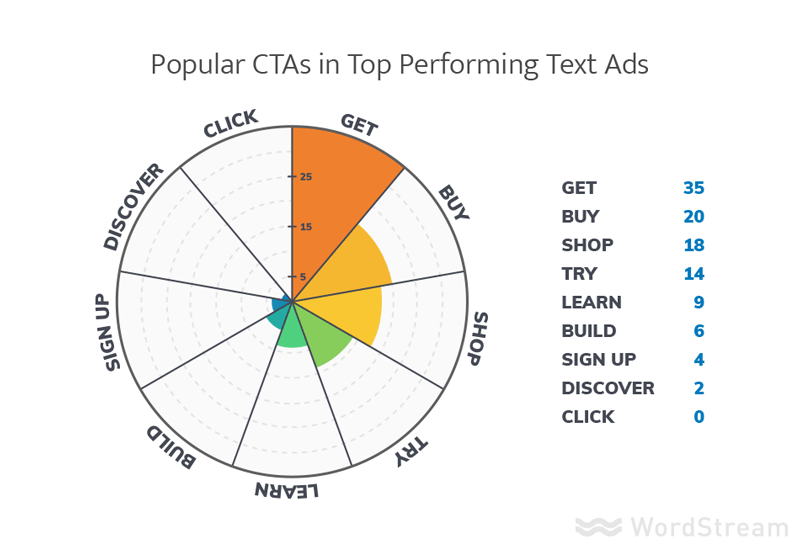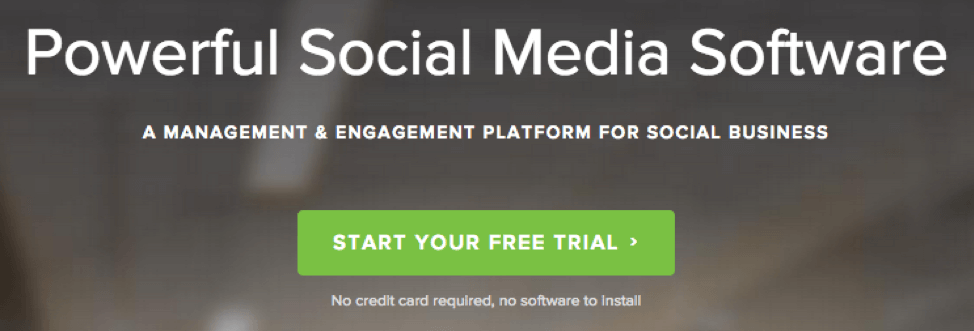On average, people perform 2.3 million Google searches per second. On almost every Search Engine Results Page (SERP), users will see an ad. These ads can be extremely effective because they appear when users search for a business, product, or service similar to yours.
Because search ads can be mapped to buyer intent, they’re perfect for targeting consumers who have already shown intent to buy. Meaning, with search ads, you can target active searchers and buyer—but only if you target them with ad copy that speaks to their intent.
But increased click through rate isn’t the only benefit of good ad copy, ad relevance is one of the key components of your Google Quality Score (which determines how much you pay per click and the overall success of your campaigns). When it comes to writing good ad copy, you only have a limited number of characters to work with, so it’s vital that you make them count.
Though there is no surefire, textbook approach to writing Google Ads copy, we’ve developed some best practices that guide us internally. And now, we’d love to share that with you. To that end, here are our best tips for writing stellar Google Ads copy.
1. Use keywords strategically
Keyword choice and placement is a bit different with Google Ads than it would be with a blog post or web copy. By echoing the user’s search words, you give them the confidence of knowing that they’re in the right place. Using keywords strategically in your ads also improves your ad relevance (and thus Quality Score), because you indicate to users (and Google) that your ad is relevant to the user’s search.
A quick note on ad groups:
Before we tackle keywords in ad copy, we need to briefly cover ad groups, as they determine the keywords you should use in your ads.
If your ad group contains too many keywords that are only loosely related, it will be difficult to write relevant ad copy (and your Quality Score will suffer). Google has formerly recommended 10-20 keywords per ad group, but most industry experts (ourselves included) agree that’s way too many keywords in a single ad group, because it doesn’t allow you to be specific enough in your ad copy. Try creating ad groups with 1-3 tightly related keywords.
Keyword placement
Once you have tightly related ad groups, then you can write ads that incorporate a mix of those keywords. This will allow you to add more variation to your ad copy, while still keeping everything hyper relevant.
When it comes to using those keywords in your ads, we recommend that you only repeat your keyword/phrase 2-3 times in your ad.
When it comes to keyword placement, try adding your keyword in the URL slug, Headline 1, Description 1, and double check that you have a CTA in your description copy (more on CTAs later):

But as always, run A/B tests on your ads using different keyword placements to find the formula that works best for your target customers.
A note about keywords on your landing page:
Good ad copy is important, but it can’t be looked at in isolation. Your landing page should also mirror the search intent and keywords that are in your ad copy.
If you have multiple keywords in your ad group, then use the highest-volume keyword from your ad group in the headline for your landing page. Then, use the other keywords naturally throughout the main text, about once per every 200 words.
2. Keep your copy concise and specific
Users who click on ads are looking for something very specific. A small business owner who wants to hire an insurance broker for her employee benefits will probably not simply search for “health insurance” or “employee benefits.” Those searches would give her a long list of blog posts and news articles that are irrelevant because they’re too general.
That business owner is more likely to search for “small business health insurance,” or “small business health insurance options.”
An insurance agent who wants to grab her attention should make an ad that specifically addresses her search query. Let’s take a look at an example:

Take a look at the first ad on our SERP from Justworks. This does a good job of matching the ad copy to the search query. The headline uses a related keyword phrase “Small Business Health Plans,” and the body includes the queried keywords “Health Insurance” and “Small Business.” In addition, the ad includes related words such as “employees,” “benefits,” and “HR compliance” that are likely important to an employer.
Furthermore, the landing page URL makes a couple things clear to the searcher. First, it uses the name of the business so the customer knows where their click will lead. And second, the URL extension is specific to the search query. Our small business owner can click on this link and feel confident that she will be directed to information about small business health insurance from Justworks.
Be sure that your ad copy and landing page URL are specific and clearly let the searcher know that they’ve found what they were looking for.
Specific numbers and dates are also a way to add specificity and credibility to your ads. Whenever possible, include specific numbers about how many businesses you’ve helped, the amount of time or money they’ve saved, a discount that’s applicable for X number of days, etc. This will lend your ads credibility:

3. Always include a call to action
This might be the most important tip of all. The ultimate goal of your ads if a user taking your desired action. Whatever it is that you want visitors to do, spell it out for them.
As far as CTA placement goes, we recommend testing ads with a CTA in the headline vs a CTA in the description text to start with.
When it comes to actual word choice, WordStream did an analysis of over 600 top performing ads and found the most popular CTAs in those ads included the following verbs:

They also found the most common non-CTA words in top performing ads were:
- Your
- Free
- Now
- Get
- Online
- Our
- Save
- Best
- Shipping
- You
Of course, some of those words won’t be applicable to your business (e.g. “shipping”), but they can serve as a starting point when building your CTA copy.
In addition to those word options, we also recommend using this list of power words from CoSchedule as inspiration for your CTA copy. CoSchedule analyzed over 10 million headlines and found the most shared headlines use power words (or highly emotive words), which they then compiled into the list above. Research has shown that emotional ads and emotional marketing are more effective, making those power words a good place to start for CTA copy.
A note about CTAs on your landing page
Again, we can’t really talk about ad copy in isolation. Your landing page CTA should mirror the CTA in your ad—creating a cohesive direction towards a single action. In addition to that, try:
- Using copy that directs action, such as “buy now,” “add to cart,” or “request a free quote.”
- Use first person language. “Get MY free quote” converts better than “Get YOUR free quote.”
- Use as few words as possible. Be specific, but not wordy.
- If you need more room, use the space under your CTA. This call to action from Sprout Social uses actionable, clear language, but they also include the words “No credit card required” and “no software to install” under the button in order to ease common customer anxieties.

- Use contrasting, bright colors. You want your call to action to pop out.
- Use clear, large, and legible font.
- Surround the button with white space to make it stand out.
- Keep it above the fold on landing pages. If your visitors have to scroll to find your button, they probably won’t see it.
- Buttons with fun graphic and unique shapes convert more leads.
Key takeaways
Google Ads can be extremely effective if your ad copy is persuasive and clear. Here are tips to keep in mind as you start writing your ad copy:
- Use your keyword/s 2 or 3 times (max) in your ad. Make sure your keyword is in the URL and Headline 1.
- Use language that speaks to the user's search intent. Use specific numbers, dates, or offers whenever possible.
- Use a CTA in your ad copy that utilizes emotive, actionable words. Make sure your ad CTA mirrors your landing page CTA.


